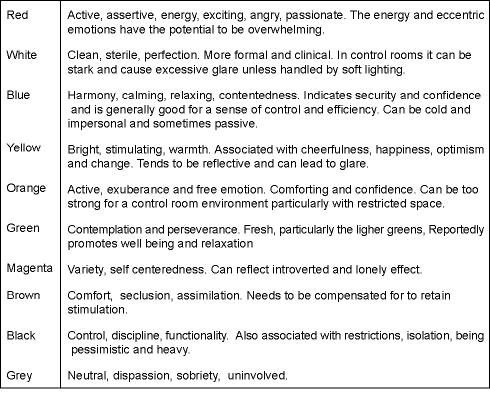
Designing control rooms often raises questions about what colours should be used for the physical surroundings. Colour is critical in displays, information presentation, learning effects, and prioritising signals and messages.
As a result, it is often an important part of the operating interfaces, but that is usually something that comes with the systems you purchase. Walls, consoles, ceilings, chairs and other physical equipment, however, have almost an unlimited number of possibilities. The colours we use for these aspects of the environment will have a psychological impact on how people work. Colour can also change perspectives and the sense of space - often a critical aspect of control rooms which tend to be situated in areas of restricted space. It is therefore important to think through what you want to achieve with colour and what implications your colour choice may have.
I have found no specific recommendations for the colour of control rooms in industry standards. Because colour reflects a number of issues, including formality, company culture, working climate, and identity, among others. The choice of colours may reflect things that are important to people or the organisation.
A couple of years ago I was at a presentation of a trendy and high profile US control room design firm where they were showing bright hi-tech control rooms that were highlighted in almost saturated colours. The visual impact was impressive, but I did wonder how people felt working in such environments. Certainly, it is unlikely that such designs would have been accepted in the UK, for example, where a more traditional approach is adopted. However, in principle, as long as the colours you choose adhere to some basic colour guidelines, you should be able to develop things around a theme. Even branding the control room in corporate colours may be a possibility. Interestingly enough, the traditional corporate colours of guarding companies are often in direct contrast with the requirements of control rooms. Guards project an image and impact for physical security of power and control with the colour of uniforms and vehicles that is often the least appropriate kind of presence you want in a confined and calm control room environment.
Psychology of colours
Colours in the work environment undoubtedly have psychological effects on people and their moods. Whether these are consistent across people and even times, however, is more questionable. One also needs to be careful of the sense of purpose you are trying to achieve. An interior designer may have a wonderful eye for the renovation of your house, but is likely to have a very different interpretation from somebody responsible for a control room. Similarly, you may want a particular calming and relaxing colour scheme in an emergency control room environment, while in another security application a slightly more stimulating colour scheme may be an advantage. Also, consider whether you want to go for a natural finish rather than a coloured one. Personally, I still favour a wood grain type finish for consoles because it is more neutral and people relate easily to it. However, you do not want the whole control room to look like this. Remember also that people have different views on colour - you just have to walk down the street and look at people's clothing to appreciate this fact. Operators have to live with the colours you choose for extended periods of time.
The psychology of colours is not a definite science. Although we tend to associate certain colours with certain characteristics, you find that there is a range of meanings to any one colour. Some of these may be positive and others may be negative for your purposes. I have given some common meanings and effects associated with specific colours below.

There are some general guidelines that you should adhere to in your colour usage that should provide a sound basis:
* Choose the intensity of your colours carefully. Pastels tend to create more of a relaxed mood and integrate physical surroundings because they soften angles and curves. Pastels tend to absorb light and create a feeling of warmth while reducing reflection and glare. On the other hand, the use of bold contrasting colours tends to create a more stimulating and exciting environment. These can be jarring though, and avoid the use of bold colours on opposite ends of the colour spectrum.
* For bigger areas it is recommended you use lower intensity colours. Blue/green colours provide a calming effect but may affect sadness. White tends to create more headaches and complaints. Bright colours can stimulate but can also promote restlessness and agitation.
* Maintain consistent colour themes and avoid the use of too many colours. Be careful when putting colours next to each other- this can have an impact on how you perceive the colours and could be jarring on the eye. Using related colours tends to integrate things better and make for a more comfortable and relaxed environment.
* Shape can be emphasised or reduced through the use of colour. Busy or complex settings can be calmed down through the use of colour.
* Illumination can play a big part in the impact of colour. Actual colour and illuminated colour may in fact differ. Lighting should therefore be looked at during the same time as the colour schemes to see how the two would interact.
Colours come in a number of shades and saturation. In combination with natural woodgrain type surfaces, it gives you a huge range of choices for a control room. Like any colour coordination, whether in your home or at work, try out the combinations of colours that you like before you make a decision. Choosing a number of separate colours that are only put together in a scheme afterwards is likely to create some unusual effects as the colours impact on each other.

Dr Craig Donald is an industrial psychologist and specialist in human factors in security and CCTV. He is the co-developer of the Surveillance and Monitoring Assessment Exercise (SAMAE) for the selection and placement of CCTV operators and presenter of the CCTV Surveillance Skills training course.
He can be contacted on telephone: 011 787 7811, fax: 011 886 6815, or e-mail: [email protected]

© Technews Publishing (Pty) Ltd. | All Rights Reserved.